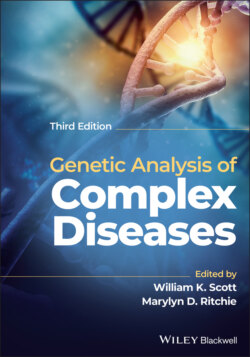Читать книгу Genetic Analysis of Complex Disease - Группа авторов - Страница 71
Co‐segregation with Chromosomal Abnormalities and Other Genetic Disorders
ОглавлениеWhile complex disorders generally do not exhibit a recognizable inheritance pattern, occasionally in a subset of patients, a complex disorder will segregate with a cytogenetic abnormality or another known genetic disorder. These associations provide valuable information regarding the location of at least one locus involved in the disease etiology. For example, individuals with trisomy 21, or Down syndrome, have an increased risk for developing Alzheimer disease. This increased risk is due to amyloid plaques resulting from an increased dosage of the amyloid precursor protein (APP) (Rumble et al. 1989). Thus, it was not surprising to find that a subset of families with early‐onset Alzheimer disease are linked to chromosome 21 and segregate mutations in the APP gene (St George‐Hyslop et al. 1987; Goate et al. 1991). Another example of co‐segregation of a complex disease and cytogenetic abnormality is the association between autistic disorder and 15q11‐q13 abnormalities. There are numerous examples of isolated patients with autistic disorder and duplications or inversions involving 15q11‐q13 (Wolpert et al. 2000). In many cases, the de novo rearrangements are thought to be maternal in origin (Lindgren et al. 1996). In addition, in the absence of these cytogenetic abnormalities, families with two or more individuals exhibiting autistic disorder display evidence for linkage (Philippe et al. 1999; Bass et al. 2000) and linkage disequilibrium (Cook, Jr. et al. 1998; Martin et al. 2000a; Menold et al. 2000) in this region. Although as yet no gene has been identified, the convergence of cytogenetic, linkage, and association data suggest that a locus involved in susceptibility to autistic disorder is located at 15q11‐q13.
